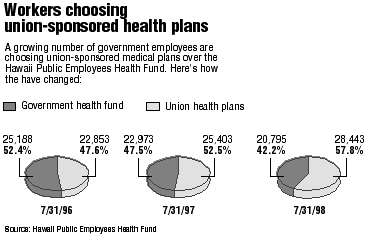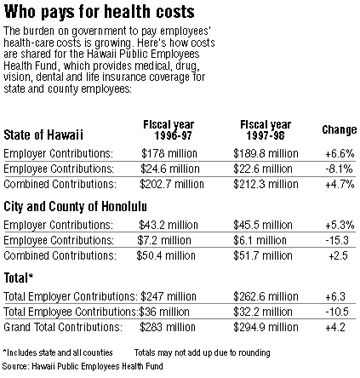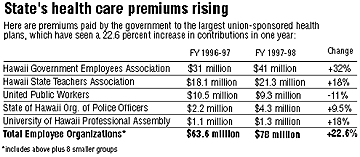

An inefficient system
All agree the current method
By Rob Perez
of providing medical benefits
needs to be overhauled—
the question is how?
Star-BulletinIllustrations by
David Swann, Star-BulletinThe system the state uses to provide medical benefits to public employees needs fixing.
It's inefficient. It's dated. It lacks sufficient resources.
But while legislators, administration officials and union representatives agree the system should be overhauled, they haven't agreed yet on how to do it.
In the meantime, the public-sector unions have started setting up their own systems for providing medical benefits to members. Because of the shortcomings of the state operation, the unions figured they could do better jobs.
So far they've been right.
State and county workers who pick union-sponsored medical insurance over state-sponsored plans typically pay lower premiums and often get better benefits.

But having two competing systems raises questions about whether the state's costs will increase and whether the hodgepodge of laws and regulations governing public-employee medical benefits is adequate.The ability to choose between union and employer health plans is a benefit few other government workers, if any, have on the mainland, experts say.
What's more, the state or county still pays a major portion of the premium even if the worker chooses a union plan.
Governments usually limit choice to save money. The idea is to minimize the chances of healthier employees leaving the employer plans for cheaper ones elsewhere, benefits consultants say. If healthy workers drop the employer plans, the employer is left with a riskier group to cover, driving up insurance costs.
The high cost of choice
In other states, governments or unions -- not both -- typically offer health insurance."The more opportunity the employee has to choose, the more likely the state is going to be left with the high-cost people," said Michael Carter, benefits expert for Watson Wyatt Worldwide in Dallas.
In Hawaii, some union officials say that trend already is happening.
Unions representing university professors, teachers, police officers and firefighters -- groups considered to be more health-conscious than the overall population -- are among the labor organizations that have started offering medical coverage in the 1990s. And their enrollments have increased while the numbers in the state-sponsored plans have dropped.
Although the unions can't refuse coverage to any member who also is eligible for state coverage, the unions can get beneficial rates if their membership as a group is considered healthier or less risky.

"The reason the rates are better is because the union plans are able to cherry pick," said John Radcliffe, an executive with the University of Hawaii Professional Assembly, the UH faculty union.Radcliffe also is a member of the board of the Hawaii Public Employees Health Fund, which administers the employer-sponsored plans for the state and counties.
UHPA began offering medical insurance this year. Members who enroll in UHPA's comprehensive family plan pay $79 a month, a 62 percent savings over the comparable state health-fund plan.
Unions are able to negotiate better deals with insurers for a variety of reasons, according to administrators of the union plans and state officials.
The state health fund is handicapped by laws that haven't changed much in decades, giving the state less flexibility in negotiations with insurance carriers. The problem has become more pronounced as the health-care business has become more complex.
In these tight budget times, the health fund office lacks sufficient expertise and resources to deal with the complexities of buying insurance.
Carriers typically assume greater risk in providing state coverage because of procurement requirements limiting the length of contracts (with no guarantee of keeping the business beyond the contract date) and because the size of the coverage pool is so large. In the insurance business, the greater the risk a carrier assumes, the higher the premiums.
Because the state is required to offer certain types of coverage statewide, sometimes only one carrier is able to bid on a contract, minimizing the benefit of a competitive bidding process.
Neal Miyahira, deputy director of the Department of Budget & Finance, which oversees the health fund, acknowledges that the system needs improvements.
"Where we are now from my perspective is kind of a hodgepodge" of laws that doesn't always work well, Miyahira said.

The shortcomings of the existing system prompted the Legislature in 1996 to pass a law mandating that the state, counties and unions work to develop a better way of doing things.The law said the current governance system "is not only cumbersome and inflexible but does not foster cost efficiency."
It also noted that health benefits are set by law and administered by an independent board, but that the amounts the governments contribute toward premiums are negotiated through the collective bargaining process.
"Consequently, there is little connection between benefit levels and costs, and limited latitude to design benefit packages that minimize costs and better meet the health care needs of employees," the law said.
Solution is years away
For reasons such as these, some believe the unions should take over all health insurance responsibilities, much like they do in some mainland markets."We think we can do a better job," said Russell Okata, head of the Hawaii Government Employees Association.
Miyahira said the administration is receptive to such a concept, though how that actually would work must be addressed.
"From our point of view, it's a very workable concept for active employees," he said.
The problem, however, has been what to do with retirees, whose premiums are paid entirely by the state or county.
The union plans, for the most part, aren't open to retirees. If the unions take over that responsibility as well, the two sides must decide the details, which could have major cost implications, officials say.
For that reason, they add, a solution to overhauling the entire system is years away.
When the government
kicks in its shareA higher percentage of the premium
By Rob Perez
is paid when workers buy union insurance
Star-BulletinPublic workers who buy medical insurance through the state get roughly 60 percent of their premiums paid by their employer.
But when they buy insurance through their unions, the government kicks in a dollar amount that often is roughly 70 percent to 90 percent of the premium.
In a few cases, the government's contribution can even cover the entire tab.
Why the difference?
Because the unions have been able to negotiate better deals with insurance carriers, typically getting greater benefits for lower premiums.
As a result, the dollar amount that the government contributes -- 60 percent of the premium for the most popular employer plan -- represents a greater percentage of the less-costly union plan.
Some critics say the state should be contributing only 60 percent of whatever the union premium is. But the contribution amount is negotiated through the collective bargaining process.
When the government's share covers as much as 100 percent of the tab, "something here doesn't pass the smell test," said Rep. Nathan Suzuki, a Salt Lake Democrat.
Suzuki and other legislators have raised other concerns involving government contributions to union plans:
When a union plan gets a refund for overpayment of premiums, none of that money goes back to the employer, even though the employer paid the bulk of the premium. The Hawaii State Teachers Association system, for instance, has averaged about $1 million annually in refunds the past several years. The money usually is used to lower premiums, improve benefits or to pay for overhead.
The state can't audit how its contributions are spent to ensure the amounts cover only costs, a state requirement, according to Suzuki.
Union and administration officials, citing an attorney general opinion, say the state gives up any jurisdiction to the money once the funds go to the union plans. That's why the state doesn't get a share of the refunds or doesn't audit the funds, they say.